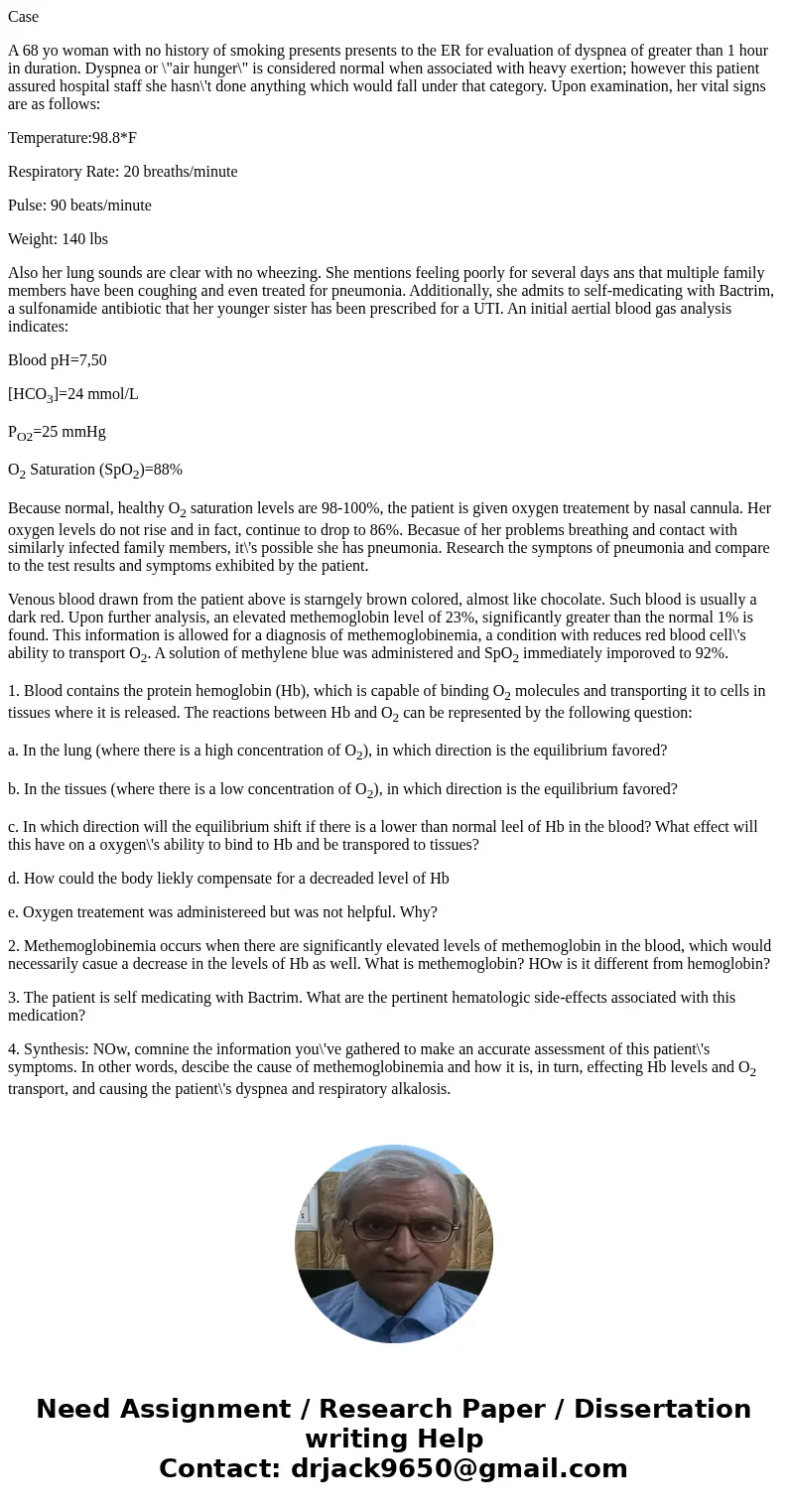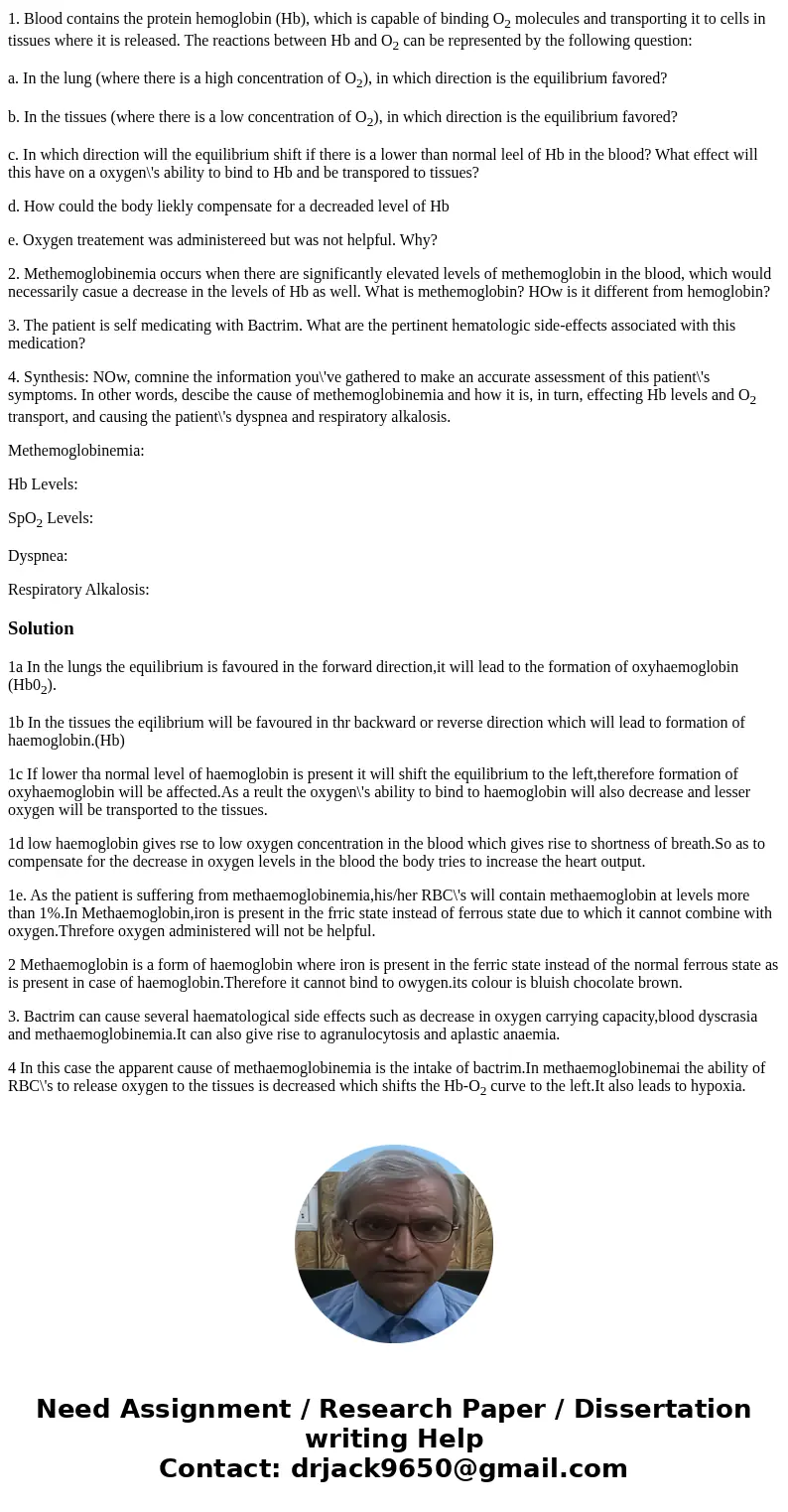Case A 68 yo woman with no history of smoking presents prese
Case
A 68 yo woman with no history of smoking presents presents to the ER for evaluation of dyspnea of greater than 1 hour in duration. Dyspnea or \"air hunger\" is considered normal when associated with heavy exertion; however this patient assured hospital staff she hasn\'t done anything which would fall under that category. Upon examination, her vital signs are as follows:
Temperature:98.8*F
Respiratory Rate: 20 breaths/minute
Pulse: 90 beats/minute
Weight: 140 lbs
Also her lung sounds are clear with no wheezing. She mentions feeling poorly for several days ans that multiple family members have been coughing and even treated for pneumonia. Additionally, she admits to self-medicating with Bactrim, a sulfonamide antibiotic that her younger sister has been prescribed for a UTI. An initial aertial blood gas analysis indicates:
Blood pH=7,50
[HCO3]=24 mmol/L
PO2=25 mmHg
O2 Saturation (SpO2)=88%
Because normal, healthy O2 saturation levels are 98-100%, the patient is given oxygen treatement by nasal cannula. Her oxygen levels do not rise and in fact, continue to drop to 86%. Becasue of her problems breathing and contact with similarly infected family members, it\'s possible she has pneumonia. Research the symptons of pneumonia and compare to the test results and symptoms exhibited by the patient.
Venous blood drawn from the patient above is starngely brown colored, almost like chocolate. Such blood is usually a dark red. Upon further analysis, an elevated methemoglobin level of 23%, significantly greater than the normal 1% is found. This information is allowed for a diagnosis of methemoglobinemia, a condition with reduces red blood cell\'s ability to transport O2. A solution of methylene blue was administered and SpO2 immediately imporoved to 92%.
1. Blood contains the protein hemoglobin (Hb), which is capable of binding O2 molecules and transporting it to cells in tissues where it is released. The reactions between Hb and O2 can be represented by the following question:
a. In the lung (where there is a high concentration of O2), in which direction is the equilibrium favored?
b. In the tissues (where there is a low concentration of O2), in which direction is the equilibrium favored?
c. In which direction will the equilibrium shift if there is a lower than normal leel of Hb in the blood? What effect will this have on a oxygen\'s ability to bind to Hb and be transpored to tissues?
d. How could the body liekly compensate for a decreaded level of Hb
e. Oxygen treatement was administereed but was not helpful. Why?
2. Methemoglobinemia occurs when there are significantly elevated levels of methemoglobin in the blood, which would necessarily casue a decrease in the levels of Hb as well. What is methemoglobin? HOw is it different from hemoglobin?
3. The patient is self medicating with Bactrim. What are the pertinent hematologic side-effects associated with this medication?
4. Synthesis: NOw, comnine the information you\'ve gathered to make an accurate assessment of this patient\'s symptoms. In other words, descibe the cause of methemoglobinemia and how it is, in turn, effecting Hb levels and O2 transport, and causing the patient\'s dyspnea and respiratory alkalosis.
Methemoglobinemia:
Hb Levels:
SpO2 Levels:
Dyspnea:
Respiratory Alkalosis:
Solution
1a In the lungs the equilibrium is favoured in the forward direction,it will lead to the formation of oxyhaemoglobin (Hb02).
1b In the tissues the eqilibrium will be favoured in thr backward or reverse direction which will lead to formation of haemoglobin.(Hb)
1c If lower tha normal level of haemoglobin is present it will shift the equilibrium to the left,therefore formation of oxyhaemoglobin will be affected.As a reult the oxygen\'s ability to bind to haemoglobin will also decrease and lesser oxygen will be transported to the tissues.
1d low haemoglobin gives rse to low oxygen concentration in the blood which gives rise to shortness of breath.So as to compensate for the decrease in oxygen levels in the blood the body tries to increase the heart output.
1e. As the patient is suffering from methaemoglobinemia,his/her RBC\'s will contain methaemoglobin at levels more than 1%.In Methaemoglobin,iron is present in the frric state instead of ferrous state due to which it cannot combine with oxygen.Threfore oxygen administered will not be helpful.
2 Methaemoglobin is a form of haemoglobin where iron is present in the ferric state instead of the normal ferrous state as is present in case of haemoglobin.Therefore it cannot bind to owygen.its colour is bluish chocolate brown.
3. Bactrim can cause several haematological side effects such as decrease in oxygen carrying capacity,blood dyscrasia and methaemoglobinemia.It can also give rise to agranulocytosis and aplastic anaemia.
4 In this case the apparent cause of methaemoglobinemia is the intake of bactrim.In methaemoglobinemai the ability of RBC\'s to release oxygen to the tissues is decreased which shifts the Hb-O2 curve to the left.It also leads to hypoxia.


 Homework Sourse
Homework Sourse